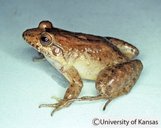|
Leptodactylus sabanensis Heyer, 1994
| family: Leptodactylidae subfamily: Leptodactylinae genus: Leptodactylus |
 © 2010 Division of Herpetology, University of Kansas (1 of 1) |
|
|
Country distribution from AmphibiaWeb's database: Brazil, Venezuela
|
|
|
AMPHIBIAWEB
|
|||||||||||||||||||||||
|
(Translations may not be accurate.) |
Country distribution from AmphibiaWeb's database: Brazil, Venezuela
|
||||||||||||||||||||||